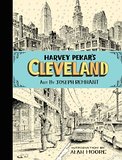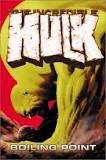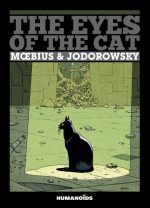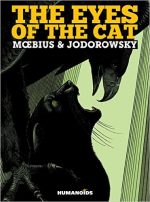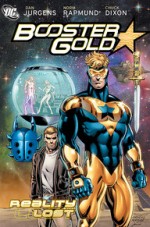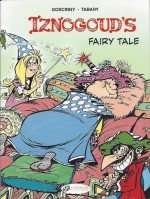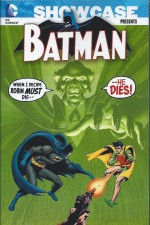
By Dennis O’Neil, Frank Robbins, Robert Kanigher, Len Wein, Marv Wolfman, Neal Adams, Irv Novick, Bob Brown, Dick Giordano & various (DC Comics)
ISBN: 978-1-4012-5153-6
After three seasons the overwhelmingly successful Batman TV show ended in March, 1968. It had clocked up 120 episodes plus a theatrical-release movie since its premiere on January 12, 1966; triggering a global furore of “Batmania†and causing hysteria for all things costumed, zany and mystery-mannish.
Once the series foundered and crashed, humanity’s fascination with “camp†superheroes burst as quickly as it had boomed, and the Caped Crusader was left to a hard core of dedicated fans and followers who hoped they might now have “their†hero back.
For comicbook editor Julius Schwartz – who had tried to keep the most ludicrous excesses of the show out whilst still cashing in on his global popularity – the solution was simple: ditch the tired shtick, gimmicks and gaudy paraphernalia and get Batman back to basics; solving baffling mysteries and facing life-threatening perils.
That also meant phasing out the boy sidekick…
Although the college freshman Teen Wonder would still pop back for the occasional guest-shot yarn, this sixth astoundingly economical monochrome monument to comics ingenuity and narrative brilliance features him only sporadically. Robin had finally spread his wings and flown the nest for a solo back-up slot in Detective Comics, alternating with caped newcomer Batgirl.
Chronologically collecting Batman’s cases from February 1971 to September 1972 – issues #229-244 of his own title as well as the front halves of Detective Comics #408-426 – the 33 tales gathered here (some Batman issues were giant reprint editions, so only their covers are reproduced within these pages) were written and illustrated by forward-thinking creators determined make the masked manhunter relevant and interesting on his own terms once more.
One huge factor aiding the transition was the fact that the publishers now acknowledged that a large proportion of their faithful readership were discerning teens or even adults, not just kids looking for a quick, disposable entertainment fix. Working through other contemporary tropes – most notably a renewed global fascination in all things supernatural and gothic – the creative staff deftly reshaped Batman into a hero capable of actually working within the new “big things†in comics: realism, organised crime, social issues, suspense and even horror…
During this period the long road to our modern obsessive, scarily dark Knight gradually revealed a harder-edged, grimly serious caped crusader, whilst carefully expanding the milieu and scope of Batman’s universe – especially his fearsome foes, who all ceased to be harmless buffoons and inexorably metamorphosed back into the macabre Grand Guignol murder-fiends which typified the villains of the early 1940s.
This mini-renaissance also resulted in a groundbreaking experiment now lauded as one of the first great extended Batman epics…
The moody mayhem begins with ‘Asylum of the Futurians’ by Robert Kanigher, Irv Novick & Frank Giacoia from Batman #229, which pitted the astounded hero against a sect of self-proclaimed mutants who might simply have been the craziest, most self-deluding killers he had ever faced.
Detective Comics #408 offered a short sharp shocker by neophyte scripters Len Wein and Marv Wolfman. Limned by Neal Adams & Dick Giordano, ‘The House That Haunted Batman’ showcased spectral apparitions, the apparent death of Robin and a devilish mystery perpetrated by one of the Gotham Guardian’s most sinister enemies. Frank Robbins, Novick & Giordano then addressed an ongoing social revolution as our hero stopped a juvenile delinquent gang-war. When the now-united kids’ occupied a palatial new building the ‘Take-Over of Paradise’ (Batman #230) led to a vicious murder. Luckily the Caped Crimebuster was on hand to solve the case before a renewed bloodbath began…
Detective Comics #409 pitted Batman against a disfigured lunatic slashing portraits and killing their subjects in ‘Man in the Eternal Mask’ (Robbins, Bob Brown & Giacoia) whilst the next issue proved to be another chilling and memorable murder-mystery from the most celebrated creative team of the decade. ‘A Vow from the Grave!’ by Denny O’Neil, Adams & Giordano at their visually spectacular best, featured an exhausted Batman hunting one ruthless killer and inadvertently stumbling into another murder in an enclave of retired circus freaks…
Multi-talented Dick Giordano was the inker of choice for the Darknight Detective at this time; his slick, lush line and brushwork lending a veneer of continuity to every penciller. Unless I say otherwise, please assume it’s him on every cited story from now on…
The Dark Knight was lured to Vietnam to save an airliner full of hostages in Batman #231 (Robbins, with Novick pencils), barely surviving a vicious vengeance scheme triggered by the ‘Blind Rage of the Ten-Eyed Man’.
Then the first subtle plot-strands were woven in a breathtakingly ambitious saga unlike anything seen in comics before. Detective Comics #411 found Batman still in the East, undercover and hunting Dr. Darrk; leader of the lethally clandestine League of Assassins so casually introduced in #405. The pursuit led ‘Into the Den of the Death-Dealers’ (O’Neil, Brown) where a climactic struggle resulted in the monster’s death and freedom for an exotic hostage he was holding. Her name was Talia…
We learned more of her in Batman #232 where O’Neil & Adams introduced her father – immortal eco-terrorist Râ’s Al GhÅ«l – in a whirlwind adventure which became one of the signature high-points of the entire Batman canon.
‘Daughter of the Demon’ is a timeless globe-girdling mystery yarn that draws the increasingly dark detective from Gotham’s concrete canyons to the Himalayas in search of hostages Robin and Talia, purportedly captured by forces inimical to both Batman and the mysterious figure who claims to working in secret to save the world…
Ra’s was a contemporary, more acceptable visual embodiment of the classic inscrutable ultimate foreign devil (as typified in a less forgiving age as the “Yellow Peril†or Dr. Fu Manchu). This kind of alien archetype permeates popular fiction and is still an astonishingly powerful villain-symbol, although the character’s Arabic origins – neutral at the time – seem to uncomfortably embody a different kind of ethnic bogeyman in today’s post 9/11 world.
The concept of a villain who has the best interests of the planet at heart is not a new one, but Ra’s Al Ghul, whose avowed intent is to reduce teeming humanity to viable levels and save the world from our poison, hit a chord in the 1970s – a period where ecological issues first came to the attention of the young. It was a rare kid who didn’t find a note of sense in what “the Demon’s Head†planned.
The spectacular tale ended with a shocking pronouncement of what Ra’s intended for Batman…
A return to relative normality came in ‘Legacy of Hate!’ (Detective Comics #412 by Robbins, Brown) as Bruce Wayne headed to Northern England for a convocation of kin gathered to settle the ownership and disposition of ancient Waynemoor Castle. Sadly, even Batman could not separate the spate of attempted murders which followed into purely human perpetrators and the manor’s vengeful ghost knight…
Issue #413 blended the spooky tone of the times with a healthy dose of social inclusion as ‘Freak-Out at Phantom Hollow!’ (Robbins, Brown) found Batman saving two abused hippie kids being picked on in a rural hamlet, only to become embroiled in a witch’s curse and mad bomber’s plot. Batman #233 was an all-reprint edition after which #234 featured the stellar return of one of the hero’s most tragic foes.
As comics became increasingly more anodyne in the 1950s, psychologically warped actualised schizophrenic Two-Face was dropped from Batman’s roster of rogues, but with ‘Half an Evil’ (O’Neil, Adams & Giordano) he resurfaced at the forefront of grimmer, grittier stories.
When a string of bizarre and brutal robberies afflicting Gotham, the baffled Batman has to use all his ingenuity to discern the reasoning and discover the identity of a ruthless hidden mastermind in time to thwart a diabolical scheme…
An aura of Film Noir redemption colours O’Neil & Novick’s ‘Legend of the Key Hook Lighthouse!’ from Detective Comics #414, as Batman tracks gunrunners to a haunted coastal bastion in Florida. However, only a supernatural intervention enables him to save bystanders who, whilst not exactly innocent, certainly don’t deserve the fate psychotic banana republic despot General Ruizo planned for them…
In Batman #235’s ‘Swamp Sinister!’ (O’Neil, Novick) some early insights into the true character of Talia and her ruthless sire manifest as the Dark Knight races to recover a stolen bio-weapon whilst over in Detective Comics #415 Robbins & Brown’s ‘Challenge of the Consumer Crusader’ sees the Gotham Gangbuster uncover an extortion ring inside the nation’s most respected product-testing organisation.
Detective Comics #400 had introduced a dark counterpoint to the Gotham Gangbuster wherein driven scientist Kirk Langstrom created a serum to make him superior to Batman and paid a heavy price. Over two further exploits Langstrom and his fiancée Francine had endured his monstrous transformations until Batman found a cure. Now that trilogy was expanded in #416 as Frank Robbins pencilled and inked his own script ‘Man-Bat Madness!’ wherein Kirk seemingly slipped back into his transformative madness. Luckily, Batman had the faith to look beyond appearances and discern a hidden factor in the scientist’s inexplicable recidivism…
‘Wail of the Ghost-Bride!’ (Batman #236, Robbins, Novick) blends mysticism with an solid murder-plot, cover-up and blistering action after which a journalist tries to become ‘Batman for a Night’ (Detective Comics #417, Robbins, Brown & Giordano) but only succeeds after experiencing a similar crime-created loss…
‘Night of the Reaper!’ – by O’Neil, Adams & Giordano from Batman #237 – is one of the most revered tales of the era: a harrowing Halloween epic which finds Robin working with his old mentor to solve a string of barbarous killings only to uncover a pitifully deranged perpetrator as much sinned-against as sinner…
Following the cover of reprint giant Batman #238, Detective Comics #418 writes a temporary finish to the short-lived career of The Creeper as ‘…And Be a Villain!’ (O’Neil, Novick) pits the Gotham Guardian against a former hero being simultaneously killed and driven crazy by his own powers. At the heart of the problem is the criminal scientist forcing Creeper to steal in return for a promised cure, but that’s no help as Batman battles a foe faster, stronger, more agile and far scarier than he…
A corpse weighed down with Batman figurines leads the hero into an underworld imbroglio packed with shameful family freaks, a ruthless master smuggler and the pitiful ‘Secret of the Slaying Statues!’ (Detective #419 from O’Neil & Novick) whilst Christmas classic ‘Silent Night, Deadly Night!’ (O’Neil & Novick in Batman #239) sees the masked manhunter striving to save a desperate, poverty-struck single-parent from making the worst decision of his life – with a little seasonal help from a higher power…
Robbins again solos for Detective Comics #420’s ‘Forecast for Tonight… Murder!’ as a radioactive dead man stalks one of Gotham’s greatest philanthropists; easily outwitting Batman’s every preventative measure. It only gets tougher when the hero discovers he might be safeguarding the wrong injured party…
The long-brewing war between Batman and Ra’s Al Ghul went to Def Con 3 in Batman #240 when O’Neil, Novick & Giordano set the scene for the groundbreaking “series-within-a-series†soon to follow. When Batman uncovers one of his opponent’s less worthy and far more grisly projects he is forced to compromise his principles and deliver ‘Vengeance for a Dead Man!’ The end-result will be open war between Batman and the Demon’s Head…
Batman had to break a blackmailer who knew all Gotham’s dirty secrets out of prison during a full-scale riot in ‘Blind Justice… Blind Fear!’ (an all-Robbins affair from DC #421) whilst in the following issue O’Neil, Brown & Giordano had the Dark Knight expose a cunning hijacking ring using radical methodology for corporate reasons in ‘Highway to Nowhere!’
Another sociopathic killer debuted in Batman #241 as the hero hunts for freelance spy Colonel Sulphur whose extortion scheme revolved around his threat to kill a Pentagon officer’s wife. ‘At Dawn Dies Mary McGuffin!’ by O’Neil & Novick sees Batman scouring Gotham in a tense race against the clock in direct counterpoint to Detective #423’s ‘The Most Dangerous Twenty Miles in Gotham City’ (Robbins, Brown) wherein the masked manhunter’s cognitive skills are tested trying to slip a Russian agent past a gang of ultra-patriots. The killers don’t care that he’s being exchanged for a captive American, they just want to kill a commie and send a message…
Batman #242-244 (and the epilogue from #245 not included in this volume) formed a single extended saga taken out of normal DC continuity. It promised to relate the final confrontation between two opposing ideals. O’Neil, Novick & Giordano opened the campaign in Batman #242 with ‘Bruce Wayne – Rest in Peace!’ With his civilian identity taken off the board, Batman gathers a small team of specialist allies – comprising criminal alternate-identity Matches Malone, scientific advisor Dr. Harris Blaine and Ra’s’ top assassin Ling – to destroy the Demon forever.
Meanwhile it was business as usual in Detective #424 where ‘Double-Cross-Fire!’ – by Robbins & Brown – played out an astoundingly cunning murder plot with Batman challenging Commissioner Gordon (and us readers) to spot the telltale clue which gave the game away. O’Neil & Novick then get all Shakespearean in #425 where ‘The Stage is Set… for Murder!’ with Batman carefully seeking to glean which thespian was plotting a big, bloody finish before the curtain comes down forever…
O’Neil, Adams & Giordano returned with the second chapter of their landmark epic as Batman #243 sees the team – plus latecomer Molly Post – bombastically invade Ra’s’ Swiss citadel moments after their intended target passes away…
Nobody suspected the ageless villain’s resources included ‘The Lazarus Pit’ which could revive the dead…
In Detective Comics #426, a spate of inexplicable suicides amongst the wealthy leads Batman to suave gambler Conway Treach: a man who just can’t lose. Soon however, the huckster learns that his grim opponent has his own system for winning ‘Killer’s Roulette!’; another suspenseful Robbins masterpiece which leads chronologically and conclusively to Batman #244 and the fateful finale wherein ‘The Demon Lives Again!‘ Sadly, despite all his supernal gifts and forces, Ra’s cannot escape the climactic vengeance of his implacable foe in dream-team O’Neil, Adams & Giordano’s compulsive climax.
With the game-changing classics in this volume, Batman finally returned to the commercial and critical top flight he had enjoyed in the 1940s reviving and expanding upon his original conception as a remorseless, relentless avenger of injustice. The next few years would see the hero rise to unparalleled heights of quality so stay tuned: the very best is just around the corner… that dark, dark corner…
© 1971, 1972, 2015 DC Comics. All rights reserved.




